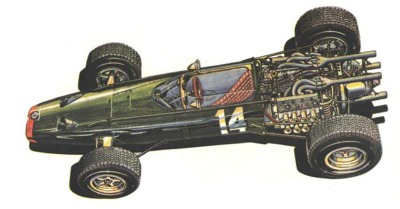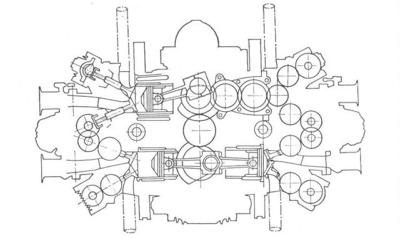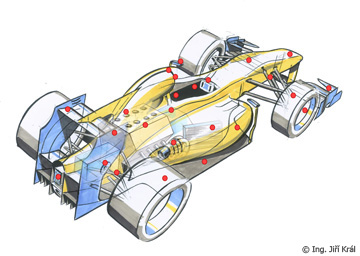BRM P83 H16 1967 specification
Miroslav Sanytrák/ Václav Král | 3.11.04 | Historie F1 - vozy

F1 history cars
This car appeared in Czechoslovakia, presented by Mike Spencer in an exhibition ride during an intermission in the Czech Grand Prix international race in Brno, September 3, 1967.
The sixteen-cylinder engine was built for a three-litre formula without turbochargers. The H-layout was chosen. It was formed of two independent engines, one above the other. You can see the general layout of the engine in the illustrating image. The upper and the lower crankshafts are joined with the straight teeth gear train. The power was output through the lower shaft. The crankcase was common. Also the cylinder head for a two neighbouring blocks was joined in one. There were 8 combustion chambers, 16 flues and bearings for the 4 camshafts. Manufacturing of the engine was very demanding and expensive. Although lubrication was common for both engines, each side of it, however, had its own cooling and fuel injection. The injection pump Lucas was propelled by an indented belt from the upper camshaft and the water pump from the lower camshaft on both sides of the engine. To reach the requested weight of 190kg, electron was used for most of casting, the cylinder liners were made of aluminium alloy with chrome plating. This engine was refined to satisfactory reliability and gained several important successes. However, when the maximum number of cylinders was limited to 12, it retired from the competition.
 |
 |
There were new F1 regulations in 1966, most significant change being the increased maximum capacity of engine to 3000 ccm without supercharging and 1500 ccm supercharged. Although the changes had been announced well in advance, there were no new corresponding engines at the beginning of 1966. Most teams decided for simple capacity enhancement of one year old engines. However, BRM chose a totally new specification. Their 16-cylinder consisted of two 8-cylinders with 180 degrees roll bite. Therefore, there were two boxers, one over the other, joined with a front gear train. There were 2 crankshafts, 8 camshafts, 32 valves and 96 valve springs. As the layout reminds of a capital H, thus the specification BRM H16. The engine, with 294 kW (400 HP), was, together with Honda, the most powerful on the grid. On the other hand, its weight proved to be too high. 695kg of kerb weight, quite uncompetitive with Ferrari's 620kg or Brabham's 555kg, and enough fuel for the abnormally thirsty engine resulted in shifting the centre of gravity towards the rear end, making the driving characteristics pretty poor. Not surprisingly reliability turned out to be the problem number one. It was virtually impossible to find optimal setting for the "most complicated engine" as it was quite aptly nicknamed. Vibration of two independent engines were never avoided and not a single racing weekend passed without a problem.BRM P83 debuted at GP Italy 1966. Jackie Stewart qualified 9th, Graham Hill 11th. The premiere was not very successful. Hill did not even start because of an engine trouble, Stewart retired after 5 laps due to a leaking fuel. The BRM H16 engine drew Colin Chapman's attention who, as an owner of Lotus, used it for Lotus 43, but Jim Clark did not see the finish line either. The BRM cars retired also from remaining two races and BRM H16 reached its best result winning in Clark's Lotus in the USA.1967 was expected to become a successful season but the team still seemed to be haunted with troubles. Mike Spencer finally won the first point for the car for the 6th position in Monaco and GP Belgium was the top success. Stewart fought his way right on Clarks tail immediately after the start, taking him over during Clarks pitstop. Struggling with his own problems was overtaken by Dan Gurney some time later, but still managed to bring the dying car to finish in the 2nd place, losing more than one minute. Spence finishing 5th, gaining 2 points, also helped the excellent result. However, Stewart returned to older BRM P261 V8 in France, coming 3rd.GP England was a home grand prix for BRM. Spence reached 11th place and Stewart 12th in practice. Stewart's fast start took him to the 6th position in the first lap, ending up at 8th later. Unfortunately, a gearbox failure forced him to retire in lap 20. Spence's collision in the 1st lap and following pitstop put him at the end of the classification, thanks to some opponents' retirements he reached 13th place but his ignition gave up in lap 44.Obviously, the car was not fit for top standings. Despite its power, it was constantly let down by breakdowns and bad driving characteristics. The team prepared also upgraded and lighter P 115, which, however, did not cross the finish line either. Spence kept using the BRM P83 and Chris Irvin in private team Reg Parnell Racing. He won 2 points for the 5th place in France. The most successful proved to be Spence gaining 9 points, ending up at 10th position in the Championship Table. Stewart's 10 points (including BRM P261 V8) put him to 9th position. BRM got 17 points and reached the 6th place in the Constructors' Table.The great expectations of H16 engine clashed hard with then technical boundaries and never reached a really competitive phase. The team retreated to more traditional V12 construction after the season.J.Neubauer
Technical specification
| Layout |
H 16 |
| Bore (mm) |
68,95 |
| Stroke (mm) |
48,89 |
| Capacity (cm3) |
2 921 |
| Output (HP) |
400 |
| Revolutions (1/min) |
10 500 |
| Valves |
16 x 2 |
| Camshafts |
2 x 2 |
|
Ĺ tĂtky






